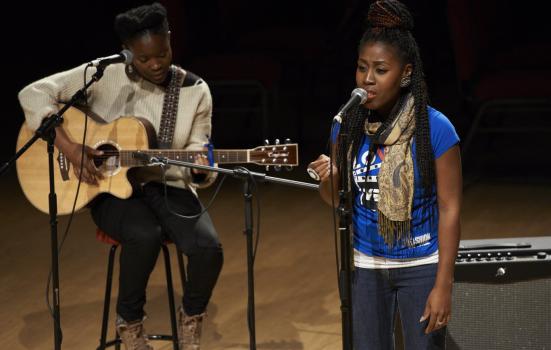Last year Youth Music more than doubled its fundraising income, exceeding its already ambitious target. Emma Holenstein reveals how they did it.

Keith Sykes
Youth Music supports over 350 music-making projects across England – around 75,000 children and young people each year. Since 1999 we’ve been fortunate to receive the majority of our funding from the National Lottery via Arts Council England.
Although fundraising has been important, it hadn’t always been a main priority. But by the time I joined the charity two years ago, it had become clear that there was a vital, pressing need to do more fundraising.
We had to make sure that we were communicating in a way that was appealing and relevant to the general public: our potential donors
Cuts to youth services meant the most vulnerable young people, including those with difficult family lives, mental health issues or disabilities, were increasingly missing out on essential support.
Communities divided by prejudice or gangs can be brought together to perform. Writing lyrics can enable a bereaved teenager to express their grief. Making hip-hop beats can help a kid understand maths in a way they never grasped at school.
I had ambitious targets and a daunting task. Having the support of our CEO Matt Griffiths to make big changes and take risks was essential in helping us to grow. But I also had to get the buy-in from the whole staff and trustee team to build an understanding of the vital importance of fundraising to the sustainable future of our organisation.
At the end of the 2014/15 financial year we had increased our fundraised income by 159% from the previous year (see our latest Impact Report for more details). Here are some of the things we did to help us exceed our goal.
Pooling our skills
Fundraising and communications functions are so closely linked. You can’t hope to increase income without demonstrating the need for and impact of your work to potential supporters.
Becoming a united development team wasn’t just about a name change and moving seats. Everyone’s role evolved so that we could make the most of our resources and strengths. Pooling our skills in copywriting, PR, social media and design, along with our fundraising expertise, has meant we’ve been able to make the most of every opportunity.
This has led to exciting initiatives, such as our charity partnership with Cambridge Audio which raised over £26,000 in just 24 hours.
Developing a fundraising strategy
During my first couple of months in post, I reviewed our internal and external landscape – existing systems and approaches, our strengths and weaknesses – and created a refreshed fundraising strategy.
The new strategy focuses on three key areas:
- People – what skills do we need to develop further?
- Prospects – how can we improve our prospecting processes?
- Proposition – how can we best demonstrate value to donors?
Refining the communications strategy
Youth Music has a very broad remit. We work all over the country with children and young people aged up to 25, supporting music-making of every style and genre. And we’re constantly evaluating the impact of our projects for young people.
With all this going on, we needed to simplify the way we talked about our work, stripping it back to what’s most important. We had to make sure that we were communicating in a way that was appealing and relevant to the general public: our potential donors. We’ve achieved this by:
- Giving young people a voice, as they are best placed to talk about what music means to them and how it’s changed their lives.
- Sharing evidence – explaining the challenges children face and how making music helps.
- Developing a consistent tone – friendly, informed, clear and inclusive.
Leading the way on digital
We’re committed to digital development. It’s important to view your website and social media channels as absolutely central to your organisation, not just an add-on.
We’ve seen huge growth in engagement by dedicating increased resources to our Twitter profile – a 38% increase in followers over the past year. We are currently revamping our website with the specific aim of significantly increasing fundraising.
The power of people
We realised that many of our supporters aren’t traditional charity donors. They tend to be people in their twenties and thirties with a keen passion for music, but not necessarily a huge disposable income. They wanted to help us but couldn’t commit to a monthly donation, so we developed Give a Gig, our flagship fundraising campaign, encouraging people to support us with a live music event.
Everything we do as a development team is joined up and carefully considered, from the words we use to the celebrities who represent us. As our profile has grown, we’ve been able to work with ambassadors who understand our impact and can spread our messages further.
In the past couple of years we’ve been represented by musicians including MOBO award-winning singer-songwriter Laura Mvula, who started out at one of our projects.
Changing more lives
This is just the beginning. We’ve got all of our strategies in place, but now we need to work harder than ever to continue to grow our appeal and increase our income. Because the more money we bring in, the more projects we can support. And that means we can change the lives of many more young people who really need our help.
Emma Holenstein is Development Director of Youth Music.
www.youthmusic.org.uk




